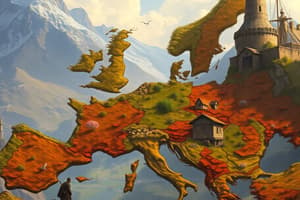Podcast
Questions and Answers
Which of the following countries is NOT commonly identified as part of Southern Europe?
Which of the following countries is NOT commonly identified as part of Southern Europe?
- Spain
- Italy
- Norway (correct)
- Greece
What characteristic is primarily associated with Eastern Europe?
What characteristic is primarily associated with Eastern Europe?
- Rich Mediterranean climate
- Historical ties to the Slavic cultures (correct)
- Influence from the Roman Empire
- High standards of living
Which region of Europe is characterized by a strong emphasis on environmental protection?
Which region of Europe is characterized by a strong emphasis on environmental protection?
- Western Europe
- Southern Europe
- Central Europe
- Northern Europe (correct)
Which of the following statements about Central Europe is true?
Which of the following statements about Central Europe is true?
What distinguishes the historical influences of Western Europe compared to Eastern Europe?
What distinguishes the historical influences of Western Europe compared to Eastern Europe?
Which of the following regions is often associated with a rich cultural heritage, including art and literature?
Which of the following regions is often associated with a rich cultural heritage, including art and literature?
Which country is NOT part of Northern Europe?
Which country is NOT part of Northern Europe?
In terms of geographical divisions, which region includes a Mediterranean climate characteristic?
In terms of geographical divisions, which region includes a Mediterranean climate characteristic?
Flashcards
Western Europe Countries
Western Europe Countries
France, Germany, UK, Spain, and Italy are examples of countries in Western Europe. These countries generally have advanced economies, strong democracies, and shared historical influences from the Roman Empire and Renaissance.
Eastern Europe Countries
Eastern Europe Countries
Eastern Europe includes countries like Poland, Russia, Czech Republic, Hungary, Romania, and Bulgaria. This region has a complex history influenced by empires like the Soviet Union and Austro-Hungarian Empire.
Southern Europe Climate
Southern Europe Climate
Southern Europe, including Greece, Italy, Portugal and parts of the Balkans, has a Mediterranean climate, ancient ruins, and a rich cultural history.
Northern Europe Characteristics
Northern Europe Characteristics
Signup and view all the flashcards
Central Europe's Position
Central Europe's Position
Signup and view all the flashcards
European Regional Divisions
European Regional Divisions
Signup and view all the flashcards
European Regional Overlap
European Regional Overlap
Signup and view all the flashcards
European Regional Diversity
European Regional Diversity
Signup and view all the flashcards
Study Notes
Geographical Regions
- Europe is typically divided into several major regions based on geography, culture, and history.
- These divisions are not precisely defined and often overlap.
- Common divisions include Western Europe, Eastern Europe, Southern Europe, Northern Europe, and Central Europe.
- The exact boundaries and inclusion criteria can vary depending on the source and context.
Western Europe
- Generally comprises countries like France, Germany, the United Kingdom, Spain, and Italy.
- Characterized by a relatively high degree of economic development, strong democratic institutions, and a shared history influenced by the Roman Empire and the Renaissance.
- Often associated with a rich cultural heritage, including art, architecture, and literature.
- Significant historical and political influence on the rest of the continent.
Eastern Europe
- This region encompasses countries like Poland, Russia, Czech Republic, Hungary, Romania, and Bulgaria.
- Historically, this region has undergone various political and social transformations, influenced by empires such as the Soviet Union and the Austro-Hungarian Empire.
- Significant historical and cultural ties to Slavic cultures.
- Experiences varying degrees of economic development compared to Western Europe.
Southern Europe
- Comprises countries such as Greece, Italy, Portugal, Spain, and parts of the Balkans.
- Known for its Mediterranean climate, rich history, and ancient ruins.
- Often characterized by a strong sense of regional and cultural identity, stemming from a shared history and climate.
- Historically tied to the Roman Empire.
Northern Europe
- Includes countries like Iceland, Norway, Sweden, Finland, and Denmark.
- Often characterized by a cold climate, high standards of living, and robust social welfare systems.
- Strong emphasis on environmental protection.
- Often associated with Scandinavian culture, design, and innovation.
Central Europe
- A region situated between Western and Eastern Europe, encompassing countries such as Poland, Czech Republic, Slovakia, and Hungary.
- A mix of historical and cultural influences from both Western and Eastern Europe.
- Often played a crucial role in establishing trade routes and interactions between different regions.
- Transition period between the two major European regions with often complex historical narratives.
Studying That Suits You
Use AI to generate personalized quizzes and flashcards to suit your learning preferences.




